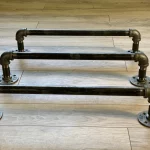Natural stone restoration is a labor-intensive process. Once completed, your stone structures will look new again and increase the value of your apartment.
Stains are often unavoidable. Oil stains, water stains and rust stains can all stain natural stone.
Also known as hit marks, efflorescence is a white deposit that occurs when salts in the soil and water come to the surface. Efflorescence is typically not a problem, but it must be cleaned regularly.
Inspecting the Surface
Before any stone restoration process is undertaken, a professional should inspect the natural stone surface and determine what type of treatment and processes to be used. This is important because using the wrong treatments and mishandling the stone can damage it even more, sometimes permanently.
For example, it is common for residential customers and janitorial or cleaning services to use vinegar to clean a calcium-based stone such as marble or travertine, thereby damaging the finish of the natural stone and creating dull, rough looking surfaces. Stone restoration contractors often get called to remediate this kind of accidental damage and could have been avoided if the homeowner or janitorial service had known what would happen to their stone finishes when they apply acidic cleaners to calcareous stones.
To prevent staining, it is recommended that all clients install mats or area rugs inside and outside of an entrance to minimize the amount of dirt, sand and grit tracked onto the stone floors. It is also recommended that all spills be wiped up as soon as they occur.
Cleaning
It is important to have the right products and tools for cleaning natural stone. Abrasive sponges, brushes and scouring pads can scratch or damage softer stones such as marble. These can also prematurely wear down the protective sealer, leaving the stone vulnerable to staining and moisture damage.
Daily maintenance of natural stone is key to avoiding build-up that requires potentially damaging scrubbing and professional restoration. Quick daily wipe-downs will keep surfaces gleaming for years to come.
Do a daily dust or sweep to remove dirt and debris from stone countertops, islands, vanities, floors, and other surfaces. Do use mats or area rugs in areas of high traffic to minimize dirt and grit that can scratch the stone. Do not place potted plants or trays on natural stone counters or floors; this can cause scratches and permanent staining.
Do clean stone surfaces with a non-acidic, natural cleaner such as Prosoco Restoration Cleaner. Do not spray insecticides or other harsh chemicals on stone surfaces; this can etch the surface and necessitate a costly professional restoration.
Polishing
A professional polishing process can revive the look of stone surfaces. It exposes crystals that are crushed, dulled, or broken over time and gives natural stone a vibrant sheen. It’s also a good way to prevent future damage, such as from acidic substances that cause etching and staining.
Rinse and dry the surface right away. Since natural stones are inherently porous, they absorb water and moisture. If left too long, this can lead to a variety of problems, such as chemical reactions or thermal soak.
Avoid using general cleaners that are not designed for use on natural stone. These chemicals can etch or discolor the surface, strip the sealer, or scratch it. For daily maintenance, rinse with clean water and a pH-neutral soap (dishwashing liquid is a good choice). Wipe up spills as soon as they occur to minimize stains. For more persistent stains, try a poultice method. This draws impurities from the stone into a substance like latex or resin.
Sealing
Sealing helps prevent future etch marks, stains and deterioration. A high-performance stone sealer binds to the pores of the natural stone creating an invisible barrier against water, acids, oil and other liquids, salts, animal waste, household cleaners and more. It’s important to select the right sealer for your particular stone and application.
Regular cleaning using a neutral, stone-safe cleaner will help to maintain the beauty and longevity of your natural stone surfaces. It is recommended that a mat or rugs be placed inside and outside entrances to minimize the amount of dirt, grit and sand that is tracked onto the stone floor. Vacuum cleaners with metal attachments or wheels should be avoided as they may scratch or etch the surface.
Spills should be blotted immediately to avoid stains. If a spill soaks into the stone it should be treated with a non-acidic soap scum remover or ammonia solution. For severe stains or scratches, professional refinishing may be required.


